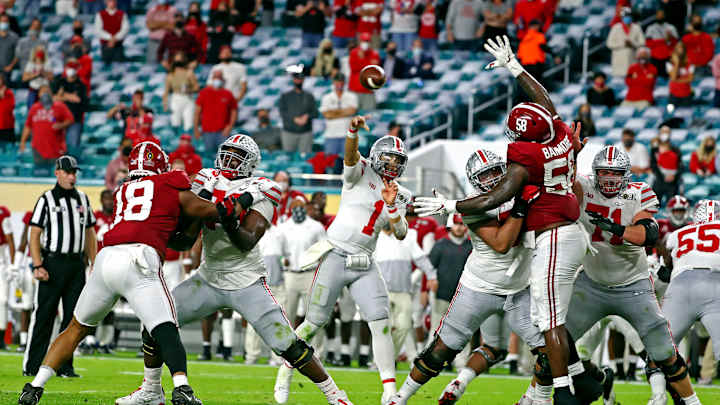Justin Fields, Passing Game Never Got Going

The college football world thought it had a shootout on its hands when Alabama and Ohio State were tied at 14 early in the second quarter.
Justin Fields and Jameson Williams drew a pass interference in the end zone and Master Teague III would rumble in for a score just a play later.
Alabama would score on its ensuing drive and wouldn’t give up the lead the rest of the way in the 52-24 win. The next Ohio State touchdown wouldn’t come until the second half of the third quarter as the Crimson Tide would cap the next three drives in the end zone. In that span of the game getting away from the Buckeyes, it was clear the Buckeye passing game wasn’t going to be able to keep the pace.
We charted each passer’s game in various ways and there are revealing trends beyond the stat-line reading 17-of-33 for 194 yards and a touchdown. The most glaring was the lack of production from the wide receiver position.
When Alabama extended the lead to what would end up as the final score, running back Najee Harris had more receptions than every Ohio State wide receiver group -- combined. The fact was as telling as any with a numerical value in a game expected to be a track meet. Sure, Alabama has great cornerback play in Patrick Surtain II and Josh Jobe, but scheming receivers open is something OSU has been able to accomplish all season long. It did on a smash concept during the first scoring drive on a 20-yard connection between Fields and Chris Olave.
Even still, there were chances for the Buckeyes with the interior pass catchers through most of the evening. Jeremy Ruckert set up the first score with a head-turning catch over linebacker Christian Harris, who was vulnerable twice on the drive when isolated against a tight end or slot receiver. Both Garrett Wilson and Williams found success against man coverage, including twice in the end zone to no avail.
Fields just missed them.
It had many of us in the press box wondering just how healthy he was after the injury suffered versus Clemson in the semifinal.
“Of course I could have been healthier, but I was healthy enough,” he said after the game. “I was able to be out there. I wasn't able to practice towards the beginning of the week last week. I kind of struggled.”
A key connection here or there of course makes a big difference in a game of this magnitude. Alabama stopped Ohio State on multiple fourth-down conversion attempts, including the short yardage variety in which Fields didn’t carry the football. It was preceded by a drive in which a drive stalled and the Buckeyes settled for a field goal.
It felt telling in a game in which holding anything back is unnecessary.
“We didn't finish a couple of those drives, didn't get the fourth down conversion, two of them, and they continued to make big plays,” head coach Ryan Day said. “They got up, I think, four scores on us, and we couldn't quite keep up. It was just a combination of things.”
Delving deeper into the numbers also told some of the story of Alabama QB Mac Jones’ success versus that of Fields, especially when it came to protection and the amount of time he had to get through his reads. Ohio State ended the night with one more sack than Alabama, but the threat of pressure wasn’t nearly as even.
Fields attempted 33 passes and we charted just three in which there was a quick and/or easy design for the primary target. Alabama had 13 such plays, scoring on four of them. Sometimes slowing a pass rush involves scheming the ball out of the triggerman’s hands without much of a decision to make. One such look, a screen set up for Teague, was set up well but the pass sailed high. More attempts in this fashion could have provided more of a rhythm.
Jones was able to get to secondary reads on 23 of his 45 attempts based on our numbers. When you factor in the 13 quick game/RPO plays in which the additional reads aren’t as much a part of the equation, it leaves just nine pass attempts in which he was unable to sit in the pocket somewhat comfortably. Fields got to secondary reads 16 times by our count, leaving 14 pressure dropbacks when the three quick hits were factored out.
The opening drive injury to Trey Sermon, not to mention losing All-American offensive lineman Wyatt Davis later on, made the climb that much more steep in a game of splitting hairs between arguably the two most talented teams in the nation. Each offensive line is elite, but Alabama’s played better (and proved healthier) on Monday night.
The newly-crowned champs actually had the advantage at the game’s most important position, too, a fact mirroring the game’s result in something few saw coming.
-----
You may also like:
Alabama Beats Ohio State in National Title Game
WATCH: Jeremy Ruckert Makes Incredible One-Handed Catch
EXCLUSIVE: Urban Meyer Joins BuckeyesNow Before National Title Game
-----
Be sure to stay locked into BuckeyesNow all the time!
Join the BuckeyesNow community!
Subscribe to the BuckeyesNow YouTube channel
Follow Brendan on Twitter: @brendangulick22
Follow BuckeyesNow on Twitter: @BuckeyesNowSI
Like and follow BuckeyesNow on Facebook
